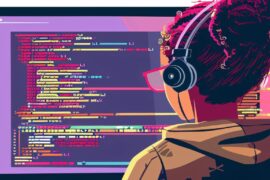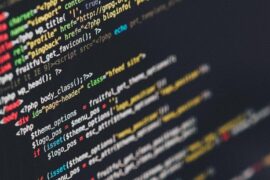Computers have revolutionized the world that we live in. People have, over time become tremendously reliant on them to accomplish several tasks.
Be it some business affair, education, recreation, or any other day-to-day affair, computers come in handy to solve almost all the problems conveniently. All this has become possible due to the myriad software programs that are developed to solve these problems.
These software programs are developed using programming languages. During the earlier times, programming was done only using some primitive programming languages which weren’t freely available for all.
The programming process, moreover, was sophisticated and was therefore difficult to get used to. As time passed, new programs emerged many of which were easily comprehendible, easy to use, and freely available for all. One of those languages is Python.
Introduced in the year 1991, Python is a high-performance, easily interpretable, general-purpose programming language.
Python is used to develop software programs, web applications, Mobile applications, User Interfaces, in the field of Data Analytics, Machine Learning, Automation, and so on. Being an open-source programming language, it has developed a vast community of committed programmers that aid each other, and help the language grow.
All the programming capabilities of Python can be attributed to its large arsenal of libraries which are developed by the Python developers and the community.
These libraries simplify some of the toughest coding tasks and in turn make developers’ lives easier in developing and working on tough subjects like Artificial Intelligence, Data Science, and so on. These libraries are one of the most important components of Python. And without them, Python wouldn’t be where it is now.
Let us discuss some of the prominent libraries of Python-
1. NumPy[1]–
NumPy is a Python library introduce in the year 2006 to support multi-dimensional arrays and matrices.
The library also enables the programmers to do high-level mathematical calculations with the arrays and matrices. It can be said to be the amalgamation of its predecessors- The Numeric, and Numarray.
NumPy is an integral part of Python and essentially provide MATLAB type mathematical functionalities to the program.
As compared to general Python lists, it occupies less memory, is convenient to use, and has faster processing. When integrated with other libraries like SciPy and/or Matplotlib, it can be effectively used for Data Science and Analytics purposes.
2. Keras[2]–
Keras is a Python library used for deep learning and building artificial neural networks. Released in the year 2015, Keras is designed for fast experimentation with deep neural networks.
Keras offers several tools that make working with image and text data easier. Apart from standard neural networks, Keras also supports convolution and recurrent neural networks.
As a Backend, Keras generally uses TensorFlow, Microsoft Cognitive toolkit, or Theano. It is user friendly and requires minimal coding to execute functions and commands. Keras is modular and has several methods for data pre-processing. Keras also offers- .evluate() and .predict_classes() method to test and evaluate models. Github and Slack host the community forums for Keras.
3. PyTorch[3]–
PyTorch is a Machine Learning library that is primarily used for Natural Language Processing and Computer Vision applications.
Developed by Facebook’s AI Research Lab and released in September 2016, it is an open-source library based on the Torch Library for Scientific computing and Machine Learning.
PyTorch provides operations to an n-dimensional array object similar to NumPy, however, additionally, it offers faster computation by enabling GPU integration. PyTorch automatically differentiates the building and training of neural networks.
PyTorch is an Open-Source library and has contributed to the development of several Deep Learning software programs- Tesla Autopilot, Uber’s Pyro, PyTorch Lightening, etc.
4. LightGBM[4]–
LightGBM is an abbreviation for Light Gradient Boosting Machine. Developed by Microsoft, and released in the year 2016, it is an open-source framework that is used to develop prediction models for Machine Learning programs. The framework makes decision-making models in the form of decision trees.
LightGBM uses a histogram-based algorithm that speeds up training while reducing memory usage at the same time.
It grows the decision tree leaf-wise which increases the accuracy of the outcomes achieved by the models. Adding to these, LightGBM also provides several parallel learning algorithms and easy construction of histograms for sparse features.
5. Eli5[5]–
Eli5 is a Python framework that is used to debug and visualize Machine Learning models. It supports several Machine Learning frameworks by default- Scikit-learn, XGBoost, LightGBM, CatBoost, lightning, Keras, and so on. Eli5 also provides the LIME and the Permutation Importance models to inspect Machine Learning pipelines as Black Boxes.
6. SciPy[6]–
SciPy is an open-source Python library for performing scientific and technical computing in Python. It has been developed by an open development community which also supports its maintenance and sponsors the developmental activities. SciPy offers several packages of algorithms and functions that support scientific computing- constants, cluster, fft, fftpack, integrate, and so on.
SciPy is essentially a part of the NumPy stack and uses multidimensional arrays as data structures provided by the NumPy module. Initially released in the year 2001, it is distributed under the BSD License having a repository at GitHub.
7. Theano[7]–
Theano is a Python library used to compile, define, optimize, and evaluate mathematical expressions that involve Multi-dimensional arrays. It was developed by the Montreal Institute for Learning Algorithms (MILA), University of Montreal, and released in the year 2007. It is an open-source library licensed under BSD License.
The library is built on top of NumPy and has a similar interface. Along with CPU, it allows the use of GPU to accelerate computations. Theano significantly contributes to large scale scientific computations and related research and is supported by a dedicated group of 13 developers.
8. Pandas[8]–
Pandas is a Python library essentially used for Data Analysis and Manipulation. Using Pandas, Analysts can perform Data Manipulation and Operations over multiple tables and time-series. It was originally written by Wes McKinney and later received a contribution from Chang She.
Released in the year 2008, it has significantly helped Data Analysts through its robust and high-performance features. Some of these features are- providing Data filtration, Merging and Joining Data sets, Group-by feature, Data set pivoting, and so on. Pandas allow analysts to import JSON, CSV, SQL, and MS Excel.
9. Tensor Flow[9]–
TensorFlow is an open-source library that is used for several purposes, mainly focusing on the Training and Interference of Deep Neural Networks. The Neural Networks trained by TensorFlow work on multidimensional arrays called tensors and hence the name. It was developed by the Google Brain Team and first release in the year 2015. It is deployable on several devices including computations with a wide range of CPUs, and GPUs, Desktops, Mobiles, and so on.
10. Scikit-Learn[10]–
Scikit-Learn is an open-source Python library for Machine Learning. It is designed to operate with NumPy, Matplotlib, and SciPy and offers several algorithms for regression, clustering, classification, dimensionality reduction, Model selection, and Preprocessing.
Scikit-Learn was originally written by David Cournpeau and released in the year 2007. It is licensed under a BSD license.
FAQs-
Q.1 Are these libraries prebuilt in a Python package?
A– No, the libraries need to be installed separately using Anaconda/Miniconda, or any other installer.
Q.2 How many Python Libraries are there?
A– There are over 130000 Python libraries available today. Some of them are free to use, and others need to be purchased. These libraries enable developers to use Python for a broad range of purposes that includes- AI, ML, Data Science, Game Development, Web development, and so on.
Q.3 What should be the course of learning Python libraries?
A– The libraries, and the sequence of learning depends on the goals and aspiration. For example, to begin working with Data Science, the enthusiast should start with Pandas, and NumPy as these libraries offer functionalities for the basics of Data Science, i.e- data analytics and statistical calculations. The same goes for any other field.
Conclusion-
Python is a popular general programming language and can be effectively used to develop applications, software programs, and so on. However, its popularity has grown significantly due to its contribution to the fields of Artificial Intelligence, Data Science, and Machine Learning. Working in these fields requires robust resources and reliable platforms. With suitable hardware at one’s disposal, these libraries are all that is required to develop quality models and programs.
[1] https://data-flair.training/blogs/numpy-features/
[2] https://data-flair.training/blogs/python-keras-features/
[3] https://pytorch.org/features/
[4] https://lightgbm.readthedocs.io/en/latest/
[5] https://eli5.readthedocs.io/en/latest/
[6] https://www.scipy.org/
[7] https://github.com/Theano/Theano
[8] https://pandas.pydata.org/
[9] https://www.tensorflow.org/
[10] https://scikit-learn.org/stable/t












